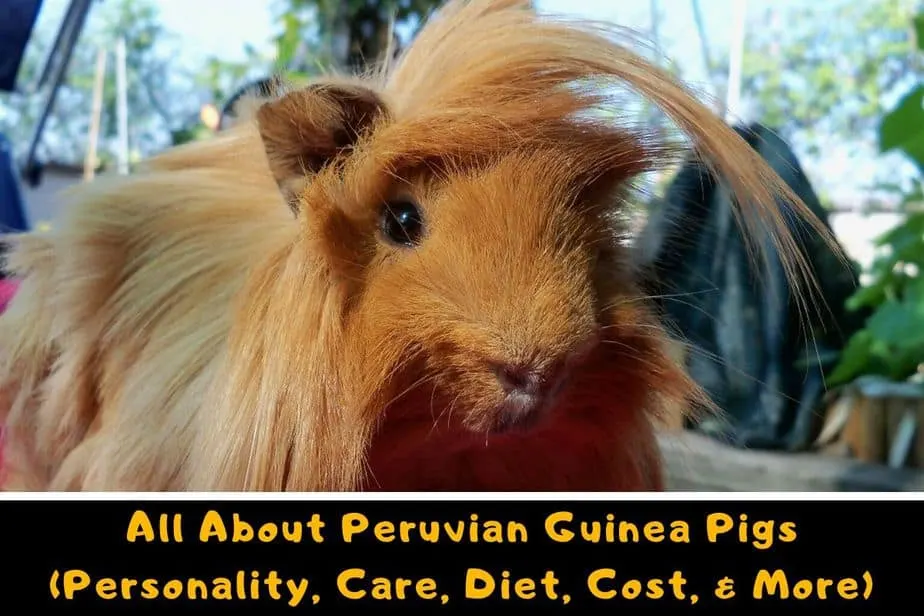Peruvian guinea pigs are one of the most attractive breeds of guinea pigs out there. They are the only guinea pig breed that was selectively bred for showing in the fifteenth century. But are Peruvian guinea pigs the right choice for you? Here is everything you need to know about them.
Peruvian guinea pigs are known for their show-like long, silky hair that can grow up to 14 inches or even longer. They have an active and fun-loving personality, but they do need extra care, especially to get them groomed in the right way. They are also a popular choice among show people and breeders but are not suitable for beginners and young children.
A couple of years back, when I was thinking of getting myself a guinea pig, I decided to learn more about all the guinea pig breed out there.
However, there was not enough information that could satisfy my quench of curiosity. Yes, there was a lot of information out there, but nothing was streamlined, and I had to go through a lot of stuff, and it was quite a lot of hassle for me.
So, I decided to make the thing really simple for other owners out there, and hence, I started learning all I can and discussing with the community and experts to find everything I could and create a thorough guide for everyone.
So, I have created an in-depth guide about Peruvian guinea pigs. If you are also interested in learning about their origin, appearance, diet, habitat, grooming, and other care, I ask everyone to stay with me until the end, and I promise you will have all your doubts cleared.
What is a Peruvian guinea pig?
Peruvian guinea pigs are long-haired guinea pig breeds that are known for their smooth and long coats. The coats usually grow from their spine of all sides and can even cover their faces.
They are also known for their fun-loving and curious personality that can many any owner go aww!
They were first brought to the USA in the 18th century and are one of the first few recognized breeds as per the American cavy breeders association.
There is a lot more to their origin which we shall discuss in detail now.
Peruvian guinea pig Origin: Where are Peruvian guinea pigs from?
Peruvian guinea pigs are one of the oldest guinea pig breeds out there. They were originated from the Andes mountain in Peru; however, it is still not sure why they were named Peruvian guinea pigs.
Earlier, they were famous as a food source, while some tribes also used to worship them as gods. However, their charming personality and cute appearance soon made them a popular pet in France(unlike other breeds), followed by the United States.
Today, they might not be as popular as other mainstream pets but still can be found in most US households.
Peruvian guinea pigs are also a popular breed of guinea pig and can be found with most professional breeders.
Keeping these guinea pigs require quite a lot of dedication and time to keep up with their grooming needs. Thus, they are not the perfect choice for all guinea pig owners.
However, if you have time and a little more money to dedicate, they are definitely one of the most rewarding guinea pig breeds.
So, now with that out of the way let us learn more about their appearance.
What does a Peruvian guinea pig look like?
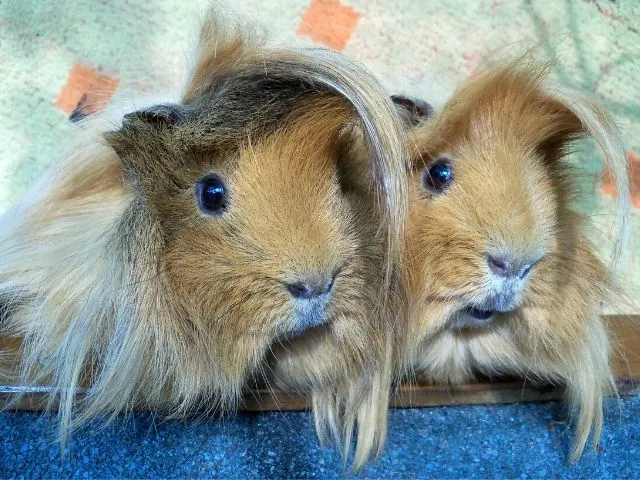
Peruvian guinea pigs have their own unique appearance, making them quite distinct from other guinea pig breeds out there.
They have straight, long hair that runs out from the spine on all sides, covering their short head, long body, and short limbs.
They also have small ears & expressive eyes. If left unchecked, their hair can cover their faces entirely, making them look like a wig of hair.
Most Peruvian guinea pigs have multiple rosettes around their body, but unlike Abyssinian guinea pigs, their hair is super long and straight.
The hair coming out from the rosette grows into two parts; while one comes towards the front, the other flows towards the back.
The coat is of equal length right from the front to back part of your guinea pigs.
They usually have two coats of hair. The overcoat is the top layer, which can grow up to 20 inches long, while the undercoat remains small and only grows up to 7 inches in length.
Peruvian guinea pig size: How big are Peruvian guinea pigs?
Peruvians are one of the larger breeds of guinea pigs out there. The average size of Peruvian guinea pigs can be anywhere between 10-14 inches in length.
While the male guinea pigs are a little longer, the females have around and short body.
Peruvian guinea pigs have a shorter head; thus, their head-to-body ratio is quite different from those of other breeds.
However, their long hair covers their entire body so well that you will hardly be able to tell the difference.
| Age | At Birth | 8 weeks | 16 weeks | Maturity |
|---|---|---|---|---|
| Growth Rate | 3-4 inches | 6-7 inches | 8-12 inches | 12-14 inches |
A newborn Peruvian guinea pig is anywhere between 3-4 inches in length. The size of the guinea pig is dependent upon the litter size.
It also depends upon the health of mother guinea pigs and more.
After 8 weeks, you can expect the Peruvian guinea pigs to reach 6-7 inches in length.
You might notice that your guinea pigs had grown quickly and had become almost double in size in the first 8 weeks itself.
However, the next 8 weeks shall be a little slower for them. They will continue to grow and reach 8-12 inches in length by the next 8 weeks.
By this time, you can tell some differences between male and female guinea pigs.
As they continue to grow and hit their maturity mark, you can expect them to be anywhere between 12-14 inches in length.
While the male guinea pigs will be a little longer, the female shall fall short by a couple of inches only.
However, sometimes the female guinea pigs can grow as big as the male guinea pig. Thus, it is not the best method to distinguish between them.
Peruvian guinea pig weight: How much do Peruvian guinea pigs weigh?
The average weight of a Peruvian guinea pig is anywhere between 900-1400 grams. While the male Peruvian guinea pigs will weigh anywhere between 1000-1400 grams, a female would weigh anywhere between 900-1200 grams.
The weight of the guinea pigs might vary depending upon the diet and care you provide to them.
| New Born | 8 Weeks | Maturity | |
|---|---|---|---|
| Male | 90-110 grams | 500-550 grams | 1000-1400 grams |
| Female | 70-90 grams | 420-450 grams | 900-1200 grams |
A newborn female guinea pig weighs anywhere between 80-100 grams on average. The weight of male guinea pigs is a little more.
However, it totally depends upon the health of the mother guinea pig and the litter size at such an early stage.
As guinea pigs grow quickly during their first eight weeks, their weight will reach 450-550 grams by the time they are eight weeks old.
If you are keeping track of their weight, you will notice that the male guinea pigs would be a little heavier than female guinea pigs at this time.
After the initial growth phase, your guinea pig will continue to grow at a slower pace and hit the plateau as they hit the maturity mark in the next few weeks.
You can expect a male Peruvian guinea pig to weigh between 1000-1400 grams and the female Peruvian guinea pigs to reach between 900-1200 grams.
Sometimes a female guinea pig can get quite heavy, and it can be difficult to tell the difference between them.
Keeping track of the weight
Keeping records of your guinea pigs’ weight is really crucial to ensure they live a healthy life.
It is like a weekly health check for your pet that you can do on your own. It would help if you used a notepad to keep records of your guinea pig’s weight.
Here is a chart you should follow:
| Weight change | Action |
|---|---|
| 0-20 grams | Usual change, Nothing to be concerned about. |
| 30-50 grams | Should lookout for other symptoms. |
| 50+grams | Reach a vet immediately. |
Guinea pigs are prey animals, and they are known for hiding diseases until it gets too bad. Thus, keeping track of weight can help you understand the health of your guinea pig.
If your guinea pig is ill, it will lose weight in most cases. So make sure you perform a weight check every month.
Peruvian guinea pig colors
Peruvian guinea pigs come in a variety of colors and patterns. They are available in Solid color, Bi-color & even in Tri-colors.
While a Solid color and Bi-color are more commonly found everywhere, a tricolor one can be a rare one to be seen.
Only a handful of professional breeders breed these guinea pigs; thus, the availability is pretty low.
You can see some of the most common colors of shade that Peruvian guinea pigs have:
| Solid colors | Bi-colors | Tri-colors |
|---|---|---|
| White | Slate-white | Slate-Cream-White |
| Cream | Cream-White | Cream-Black-Brown |
| Black | White-brown | |
| Grey | Slate-cream | |
| Brown | Black-White |
You can definitely find different color Peruvian guinea pigs from what I have mentioned, but these are some most popular colors available out there.
Peruvian guinea pig life span: How long do Peruvian guinea pigs live?
The average lifespan of a Peruvian guinea pig is six years. While some guinea pigs live for five years, only others might live for up to 8 years as well.
The Guinness book of the world record is held by a Peruvian guinea pig named snowball who lived for over 14 years.
If you provide the right living environment, diet, and care to your guinea pigs, then they can live a long life. Peruvians are primarily known to live the longest as compared to other guinea pig breeds out there.
Peruvian guinea pig personality: Are Peruvian guinea pigs good pets?
Peruvian guinea pigs carry one of the most charismatic personalities of all. Known for their fun-loving and curious behavior, they get well with kids and family members.
If you are looking for a breed you can hand-feed, pat, and cuddle, then Peruvian guinea pigs might be the best choice.
Peruvian guinea pigs are considered a calm and social breed that gets along with most other guinea pig breeds.
They are also easier to train as they have an outgoing personality. However, there are not many tricks which they can perform as their long coat can be a trouble for them.
Peruvian guinea pig care
Peruvian guinea pigs have some of the most extreme care needs among all guinea pig breeds. They are known for their long hair covering their entire body, but that doesn’t remain clean all by itself!
You need to help them maintain a clean and healthy coat. Unlike short-haired guinea pig breeds like Teddy or Crested guinea pigs that don’t have much grooming needs, Peruvian guinea pigs require a considerable amount of time to look picture-perfect all the time.
Apart from grooming, there are some other essential supplies you need to look out for. Diet, Habitat, Grooming are some of them. Let us learn about each of them in detail.
Peruvian guinea pig diet: What do Peruvian guinea pigs eat?
Guinea pigs require a balanced and good diet to remain healthy. Providing the right nutrition and care is all you need to ensure your guinea pigs live a long life. But what do Peruvian guinea pigs actually eat?
A Peruvian guinea pig’s diet consists of 80% hay, 15% fresh vegetables, 5% pellets, and some occasional treats. If you could somewhat maintain this ratio, then your guinea pig is never going to suffer due to diet, at least.
The significant nutrients, including fiber and carbs, come from the hay itself. Vegetables contribute towards the rest of the nutrient’s needs, including Vitamins and Minerals.
Fresh fruits are also a great way to bring some spice to their diet. They also contribute towards the nutrients need at the same time bring some change in the taste.
We have an in-depth article written about the guinea pig diet, where you can learn more about their diet plan in detail.
Hay
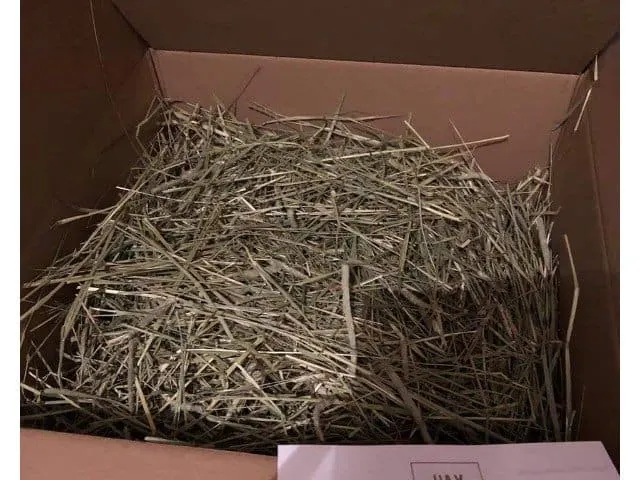
As we have already discussed, hay is an essential part of your Peruvian guinea pig’s diet. There is a wide range of feed available in the market, but your guinea pigs cant eat all the variety of hay.
The most suitable type of hay for your guinea pigs is Timothy hay and Orchard hay. These hays have the right balance of nutrients needed by our guinea pigs.
Some other types of hay, including Meadow, Oats, Bermuda, etc. doesn’t contain the required balance. They are also higher on calcium and proteins, which are known for some common health issues in guinea pigs.
You can learn more about hay for your guinea pigs from our in-depth articles below. I strongly suggest you read those as hay is the essential part of your guinea pig’s diet, and you should definitely learn all about it.
Fresh vegetables
Vegetables are another essential part of your guinea pig’s diet, which you cannot forego even for a day. Did you know there are a lot of guinea pigs that suffer from scurvy due to lack of Vitamin C?
Vegetables being their primary source of Vitamin C, you need to make sure you include in their daily diet. Vegetables are also a great way to bring some flavor into your guinea pig’s diet.
There are over 70 varieties of vegetables that your guinea pigs can eat. However, you don’t need to get a whole buffet of vegetables for them at once.
Experts recommend serving 5-6 different types of vegetables to your guinea pigs at a time. While the total serving size shouldn’t be more than a cup, you can definitely go ahead and serve it in two portions.
Vegetables like Bell peppers, Cilantro, Lettuce can be provided daily to our guinea pigs while other veggies like Tomatoes, spinach, carrots, zucchini, cucumber, kale can be served sparsely over the week.
You can read more about which vegetables are rich in vitamin C and what to do if your guinea pigs don’t munch on veggies from our articles below.
Please note: If you want to add any new vegetable in your guinea pig’s eating regimen or change their present eating routine, then you ought to do it gradually. The digestive system of your guinea pigs is sensitive, and any quick change can undoubtedly set it off-balanced.
Pellets
Pellets are also an essential part of your guinea pig’s diet. While it only accounts for 5%, it undoubtedly plays a vital role in some guinea pig’s diet.
If your guinea pig is picky on veggies and they don’t like eating vegetables like Bell Peppers, cilantro, spinach, etc. then you might need to get them a Vitamin C fortified pellets for an additional supplement.
Pellets are not a replacement for veggies; however, they can provide your guinea pigs with much-needed Vitamins and Minerals, which they lack otherwise.
Most experts recommend serving 1/8-1/6 cup of pellets to your guinea pigs daily. The serving size will depend upon the age, diet, and health of your guinea pig so, look out for the same.
Always make sure you feed your pellets slowly. Don’t dump a full bowl right away. Yes, your guinea pigs will not eat them all the time, but the pellets lose their nutrients lying in the open.
Your guinea pigs are also more likely to pee on the bowl or even toss the bowl away for no reason. Thus, small servings twice a day is a wise decision to make.
Treats
Treats are a great way to keep your guinea pigs happy. Your guinea pigs can’t stop popcorning once they know a treat is on their way. Treats also help to spice up their diet and is a great positive reinforcement for training them.
However, you should only serve small servings of treats once or twice a week. I like to mix commercial treats along with fruits and serve them alternatively.
Say, you helped a commercial treat on Sunday, then I shall toss a fruit on Wednesday or so. Keeping a gap of a few days between the serving and serving limited quantity can help in preventing the bad impact treats can have on your guinea pigs.
Treats contain a lot of sugar in it. If served regularly, treats can lead to obesity, diabetes, and other health issues in guinea pigs. Thus, make sure you serve it sparsely.
Don’t get tempted looking at your guinea pigs cute little face or listening to their wheeking when they want more. You can toss a little extra in, but make sure you don’t serve them too much either.
Commercial treats are available in a wide range of variety, but not all of them are safe for your guinea pigs. Try to avoid ones that have lots of nuts and seeds in them.
Fruits are also used as treats for guinea pigs. While not all fruits can be served to your guinea pigs, still there is a handful of them which you can go with.
Fruits like apple, orange, grapes, kiwi, strawberries, etc. are rich in Vitamins and minerals, which makes them a healthy choice as well. You can also serve a lot of other fruits to your guinea pigs.
We have created an in-depth guide of 70+ fruits for your guinea pigs, which you can go through to learn more about them.
Peruvian guinea pig habitat
Habitat is the most basic need of any guinea pig, and the same is true for Peruvian guinea pigs as well. Peruvian guinea pigs do need some extra care when it comes to setting up an ideal habitat for them.
Some essential supplies you would need to set up a perfect habitat for your guinea pig would be a right size cage, good quality bedding, food bowls, and water bottles, and some toys and hiding spaces for entertainment.
Let us dive a little deeper into the supplies for your Peruvian guinea pigs.
Peruvian guinea pig cage
cage is one of the first essential supplies you would need for your Peruvian guinea pigs. The size of the cage and the type of enclosure you get are going to decide further what kind of food dishes, water bottle, and bedding you can go with.
So, let us begin by looking at the cage for your guinea pigs. Many new owners make a mistake while buying a cage for their first guinea pigs.
Either they get a smaller enclosure, or they get an inappropriate cage for their guinea pigs. I would recommend doing a little research on the pen before buying one for your guinea pigs.
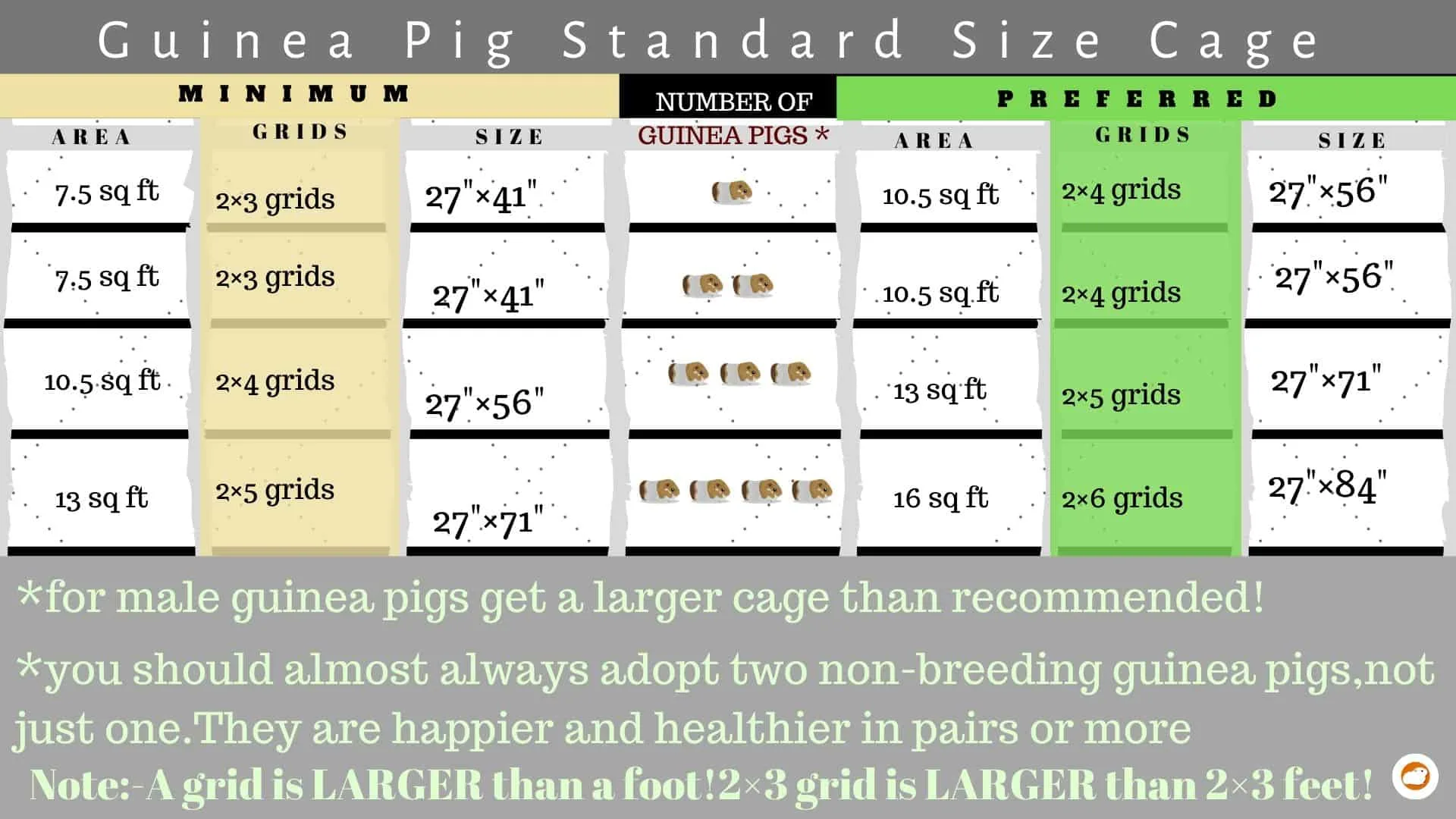
The cage should be at least eight sq feet in the area to house a pair of Peruvian guinea pigs. Since guinea pigs are caged animals and they are going to spend a lot of their time in their cage, it is wise to get a large enough enclosure for your guinea pigs.
The cage should comfortably accommodate all the supplies needed by our guinea pigs and should have plenty of space for them to eat and play.
You should also make sure you place the cage in the right spot. Few things you should look out for are:
- The area should be well-ventilated.
- There should not be any direct sunlight coming from windows or ventilation.
- The temperature of the room shall be stable.
- There should not be any drafts that can make your guinea pigs cold.
If you live in an area where the temperature drops a lot, then you should consider getting a heater as well.
This is really helpful in maintaining a pleasant living environment for my guinea pigs, and the coolest part is you don’t have to check the temperature to turn it OFF or ON manually.
Bedding
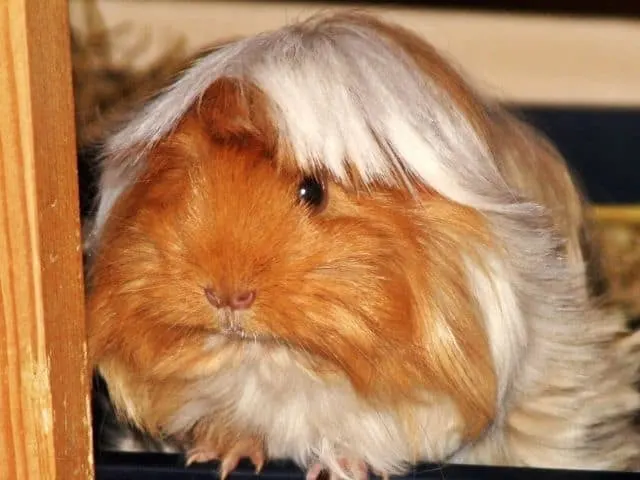
Bedding is the second most crucial component of a good guinea pig’s habitat. Good bedding does help in a lot of ways.
- It helps in absorbing the pee and keeping the cage dry.
- Protects the feet of your guinea pigs from the hard surfaces and wire mesh.
- Provides additional insulation to your guinea pigs.
There is a wide range of bedding materials available in the market. Fleece, paper, wood shavings(aspen), hemp, etc. are some popular choices. However, not all of them are safe for your guinea pigs.
You must check that your bedding is safe for your guinea pig before buying one. If you have a Peruvian guinea pig, I would definitely recommend using fleece bedding for them.
Bedding like aspen, paper, etc. can get stuck on their coat, making their coat dirty and thus more time to clean. Also, cleaning poop in such bedding is pain; therefore, the poop ends up getting into your guinea pig’s coat, making it dirty.
Fleece bedding comes with the perfect solution as it is super absorbent, easy to clean, and nothing can get into your guinea pig’s coat that way.
Food bowl
food bowl and hay racks are some other supplies needed by our guinea pigs. While the food bowl is used to serve veggies and pellets, hay racks help in keeping all the hay in a place, which makes cleaning a little bit easier.
Yes, your guinea pigs are still going to toss some veggies and hay around the cage but not as bad as it can be without these bowls and racks.
Always make sure you get a tip-proof food bowl for your guinea pigs. If you get a dish that can be tipped easily, then your guinea pig will definitely tip it. They are known for such notorious activities.
Water bottle
A water bottle is also an essential part of the guinea pig’s cage. A guinea can drink anywhere between 50-300 ml of water daily. Thus, making sure you get a water bottle for your guinea pig is really crucial.
Using a good quality water bottle is critical to prevent the bedding from getting soaked. Cheap quality water bottles tend to drip water, which can soak the bedding and make your guinea pigs ill.
Another primary concern is running out of the water when you are not around. That can make them dehydrated and thus lead to a lot of health issues in them.
There is a lot more you need to learn about providing water to your guinea pigs. I would recommend you go through our in-depth guide on the water for your guinea pigs.
Toys & hiding spaces
toys and hiding spaces are a great addition to your guinea pig’s cage. Being prey animals, guinea pigs need to have some hiding spaces around their cage where they can run to protect themselves.
Hiding spaces makes our guinea pigs feel secure, and they love to take a nap in them. Toys are another significant component of the habitat. Guinea pigs are smart and active animals.
They need something or someone to interact and keep themselves busy. If your guinea pig is idle, sluggish, or biting their cage, then it can be a sign of boredom in your guinea pigs. Make sure you have something in their cage to keep them entertained and happy.
How to groom Peruvian guinea pig?
Grooming Peruvian guinea pigs need some dedication and time from their owners. While a short-haired guinea pig can maintain their coat well and remain clean, long-haired guinea pigs like Peruvian guinea pigs don’t do that well.
Grooming of Peruvian guinea pigs includes Nail trimming, Brushing, Grease gland cleaning, some hair cut, and occasional bathing.
Maintaining a healthy and tangle-free coat can be a challenge, especially for guinea pigs whose coat can grow up to 20 inches in length.
Thus, that’s the reason a Peruvian guinea pig is not the right choice for beginners.
However, if you can dedicate the effort and care, they need you can definitely keep a Peruvian guinea pig healthy and happy.
Let us begin by having a look at some grooming task you need to do:
Brushing
Brushing your Peruvian guinea pig daily is important to maintain a healthy and clean coat. Peruvian guinea pigs have a long coat that can get up to 20 inches in length.
While they do self groom themselves but that is not enough in most cases. You need to brush their coat daily to make sure any dirt, debris, hay, or other particles that are trapped in their coats gets removed.
It is easy to brush a Peruvian guinea pig. Just take a soft bristle brush and brush towards their hair growth. Make sure you brush slowly to ensure you don’t pull their hair too much as it can hurt them bad.
You can begin brushing from their nose and end at their rump. Do remember Peruvian guinea pigs don’t enjoy brushing at their rump area, so make sure you do it carefully.
You can use a treat as a bait to keep them busy while you brush them.
Nailcare
Trimming the nails of your Peruvian guinea pig is also an essential part of the grooming schedule for your guinea pigs. Guinea pig’s nails grow pretty fast, and they will need a trim every month.
Not trimming the nails on time can be bad for your guinea pig’s health. Your guinea pig might hurt each other with their sharp nails; they might also have feet infection as the nails grow and get into their skin deeper.
Thus, make sure you trim it regularly. I can understand it can be daunting for a first-time owner to trim their guinea pig’s nail. You can ask a vet to cut the nail for the first time and watch how they do it.
You can also request a friend to join you for help so that they can hold your guinea pig while you cut their nails.
You can watch out this video to learn how to do it correctly:
A quick tip: Use a towel to wrap your guinea pig and hold them firmly. Offer them a treat so that they remain calm and use a flashlight and place their paws over it, you can now see where their blood veins are.
Make a cut keeping some margin from their blood veins. If by mistake, you cut a little extra and blood start coming out, you can use some cornflour and apply it at the nails. Press the nails firmly for a minute, and you are good to go.
Grease gland
Grease glands are an opening located at the end part of your guinea pig’s spine. Guinea pigs use the greasy substance that they secrete from these glands to mark their territory or call for mating as well.
If you ever notice a peculiar smell(especially in males), then you can suspect it is coming from their grease gland. While some guinea pigs have more active grease gland then others, they need more maintenance.
If your Peruvian guinea pig has an active grease gland, then it might be a trouble to maintain it clean. You might need to trim the hair around their rum area to clean their grease gland properly.
We have an in-depth article about grease glands and how to clean it. You should definitely read it if your guinea pig has an active grease gland, and you are looking to clean the same.
Hair cut: how to cut Peruvian guinea pigs hair?
Peruvian guinea pigs have an extra-long coat. While it looks gorgeous to look at, it is as hard to maintain as well. If you want to keep a healthy coat, then you might need to give them a trim every month.
You can also visit a grooming service nearby for a haircut, but it can get costly in the long run. So, better get a pair of good scissors and give it a try. If their hair is touching the ground, then you can say that its time to give your Peruvian guinea pig a trim.
Take a single lock of hair between your finger and cut the hair off. Repeat on all sides to make sure you give them an even cut. You should make sure you trim the hair equally in the round shape so that you don’t make their coat look ugly.
You can use any hair thinning scissors to make the cut. Do make sure you are careful while trimming so that you don’t end up hurting your guinea pigs.
Bathing
Peruvian guinea pigs get dirty more than any other breeds. As their hair touches the ground, the dirt and food particles get accumulated in their coat.
This can lead to a dirty coat as well as some foul smell coming out from their coat as well. You might need to bath your Peruvian guinea pigs every few months.
While this may not apply to other guinea pig breeds, but for Peruvians, it is essential to bath them whenever they get dirty.
Sometimes your vet might ask you to bath your guinea pigs regularly, especially if they are suffering from a skin disease and mites. In such a scenario, you might need to give them a more frequent bath.
We have a full detailed article about how to bath them and when you should bath them, which you can refer to for more information.
Where to buy Peruvian guinea pigs?
There are a handful of rescues and breeders all around the US and UK where you can get your first Peruvian guinea pigs from. I would suggest you go ahead and try out some nearby rescues first.
Many new guinea pig owners get Peruvian guinea pigs not knowing about their care need, and later, they leave them as they can’t keep up with their piggies.
Such piggies can be found in the rescues nearby. If you are sure you want to get a Peruvian guinea pig, go ahead and search for rescues nearby. If you can’t find any, then you can check some professional breeders around to get one.
Always make sure you enquire about the medical history of the guinea pig and their diet and stuff before going ahead. I know you are very excited to get one for your family, but don’t forget to go through some regular health checkups before getting one.
You must lookout for good signs in the guinea pig before getting one.
- Active and moving around
- Eating their food properly
- Solid and usual poop
- Soft and smooth looking fur
These are some of the signs you must look for before getting your Peruvian guinea pig. You must also see the guinea pig is not showing any signs of illness. But obviously, a shelter will not give you an ill pet, but it is always good to go ahead and look out carefully before adopting one.
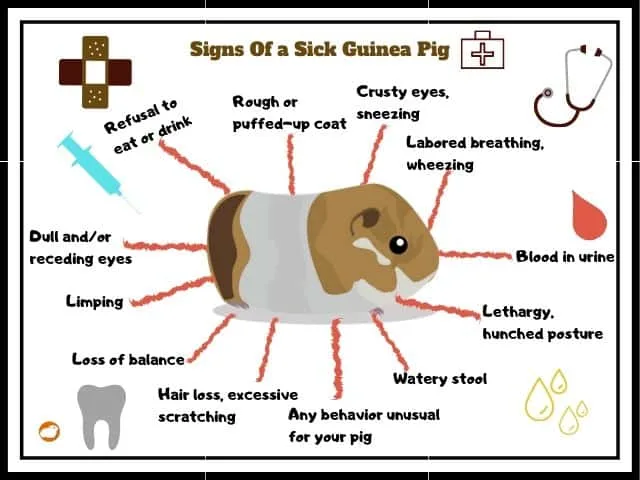
How much does a Peruvian guinea pig cost?
Peruvian guinea pigs can cost you anywhere between 30$-80$ on an average. The cost depends upon the breed quality, their color, and pattern and from where you get one.
If you get your Peruvian guinea pig from a rescue, you can expect to pay around 50$ for a Peruvian guinea pig. While some famous guinea pig rescue like LAguineapigrescue can offer you a pair for much less price, you can still expect to pay around 60-80$ for a pair in most rescues.
The price shall vary depending upon the rescue and your location. So, just keep that in mind.
The cost can go significantly higher if you get one from a professional breeder. You can expect to pay anywhere between 60$-100$ if you are planning to get a Peruvian guinea pig from a licensed breeder.
Do Peruvian guinea pigs shed?
Yes, Peruvian guinea pigs have a lot longer coat than any other guinea pig breeds out there, which means they shed a lot more than other breeds do.
While the shedding is not significant during fall & winter, you can expect a heavy shedding during spring and summer. All guinea pigs breed tends to shed more during the spring and summer to get rid of excess hair so that their body temperature can remain down during those heat waves.
Brushing your guinea pigs daily can help to get rid of excess hair as well. Doing so will ensure the hairs are not tangling all-around your Peruvian guinea pig.
If you want to learn more about shedding in guinea pigs, we will encourage you to read our in-depth guide on it.
Are Peruvian guinea pigs hypoallergenic?
Peruvian guinea pigs are not hypoallergenic at all. In fact, Any breed of guinea pigs can cause allergic reactions in human beings.
Many people claim that skinny pigs are hypoallergenic, but the reality is far from their claims.
Any living being with fur, coat, or feather can cause allergic reactions to human beings. It is just that some are more susceptible to the allergy while other’s aren’t.
Many people are allergic to hay, rather than guinea pigs. So make sure you look that out as well.
If you want to learn more about guinea pig allergy and how to live with it. I would recommend you to check out our article.
Conclusion
- Peruvian guinea pigs need a cage of atleast 8 sq feet area to eat play and exercise.
- Good quality bedding is must to ensure your guinea pigs remain healthy and their cage remains clean. I would prefer using fleece as it doesn’t get stuck in their coat like any other bedding.
- Providing a good quality and balanced diet is a must to ensure they remain healthy.
- Make sure you provide them with enough floor time to play and exercise
- Peruvian guinea pigs need daily brushing and monthly nail trim to ensure they remain clean and hygienic.
- Make sure you don’t clip their nails alone if you are a total beginner. Take help from a vet or a friend.
- Make sure you bath your Peruvian guinea pig only when it is required. Bathing can rip the natural oil fom their skin which is bad for their health.
- Regular vet visit(once in 3 months) helps in preventing diseases so that your guinea pigs can live a long and healthy life.
- While going to get one always ensure that they are healthy. A healthy coat, glowing eyes, good sound, and good dental health helps identify the right one.
Sources: Guinea pigs, Biology of the Guinea Pig, Housing Guinea pig colony, Guinea pigs housing, Petsaver guinea pig guide, Guinea pig care, GUINEA PIG GENERAL CARE GUIDE, The effects of lowering the bath temperature, Weight Loss in Guinea Pigs, THE DEPLETION OF VITAMIN C, Discussion with a vet, The Journal of Nutrition, NCBI, NCBI, Journal of animal health, Petmd, The Effects of Diet on Anatomy, Physiology, and Health in the Guinea Pig.
